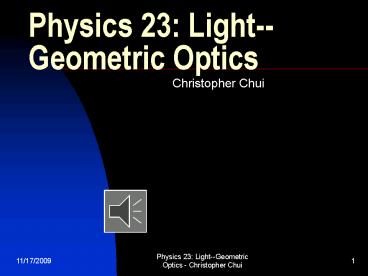Physics 23: LightGeometric Optics PowerPoint PPT Presentation
1 / 12
Title: Physics 23: LightGeometric Optics
1
Physics 23 Light--Geometric Optics
- Christopher Chui
2
The Ray Model of Light
- Light travels in straight lines
- Geometric optics refers straight-line rays of
light at various angles - Reflection When a narrow beam of light strikes a
flat surface, the angle of incidence, qi, is the
angle an incident ray makes with the normal to
the surface. The angle of reflection, qr, is the
angle the reflected ray makes with the normal - For flat surfaces, the incident and reflected
rays lie in the same plane with the normal qi
qr
3
Formation of a Virtual Image by a Mirror
- The image appears as far behind the mirror as the
object is in front the image distance, di,
equals the object distance, do. The height of the
image is the same as that of the object. - It is a virtual image, because the image would
not appear on a paper or film placed at the
location of the image.
4
Formation of Images by Spherical Mirror
- A spherical mirror is called convex if the
reflection takes place on the outer surface of
the spherical shape. A mirror is called concave
if the reflection surface is on the inner surface
of the sphere - The point F, where rays parallel to the principal
axis come to a focus, is called the focal point
of the mirror. The distance between F and the
center of the mirror, length FA, is the focal
length, f. - Focal length of mirror, f r/2.
5
Finding the Image Position for a Curved Mirror
- Ray 1 is drawn // to the axis therefore, it must
pass along a line through F after reflection - Ray 2 is drawn through F therefore it must
reflect so it is // to the axis - Ray 3 is chosen to be perpendicular to the
mirror, and is drawn so that it passes through C,
the center of curvature. Because it is
perpendicular, it will be reflected back on
itself - Object distance, do, is the distance of the
object to the center of the mirror - Image distance, di, is the distance of the image
to the center of the mirror
6
Mirror Equation
- 1/do 1/di 1/f where f is the focal length
- f r/2 where r is the radius of curvature of
mirror - Lateral magnification, m, is height of image /
height of object m hi / ho - di / do - Hi is ve if the image is upright, -ve if
inverted - Di and do are ve if both image and object are on
the reflecting side of the mirror, otherwise ve - Magnification is ve for an upright image and ve
for an inverted image
7
Convex Mirror
- The image of a convex mirror is always virtual
and erect - The radius of curvature of a convex mirror is
negative by convention?focal length is -ve
8
Problem Solving for Spherical Mirrors
- Always draw a ray diagram, which serves as a
check - Use the mirror equation and follow the sign
convention - When the object, image, or focal point is on the
reflecting side of the mirror (on the left side),
the corresponding distance is considered ve. If
any of these points is behind the mirror (on the
right), the corresponding distance is ve. - The image height hi is ve if the image is
upright, and ve if inverted, relative to the
object (ho is always ve).
9
Index of Refraction
- The ratio of the speed of light in vacuum to the
speed v in a given material is called the index
of refraction, n, where n c / v - Refraction Snells law n1 sin q1 n2 sin q2
- Total internal reflectionlight passes from a
material into a 2nd material with smaller index
of refraction, the light bends away from the
normalat a particular incident angle, the angle
of refraction will be 90o. This incident angle is
called the critical angle, qc - sin qc (n2 / n1) sin 90o n2 / n1
10
Thin Lenses Ray Tracing
- Any lens that is thicker in the center than at
the edges will make // rays converge to a point,
and is called a converging lens - Lens that are thinner in the center than at the
edges are called diverging lenses because they
make // rays diverge - The power P of a lens 1/f
- The unit for lens power is the diopter, D
- 1 D 1 m-1
11
Find the Image Position of a Thin Lens
- Ray 1 is drawn // to the axis it is refracted by
the lens so it passes along a line through the
focal point F - Ray 2 is drawn on a line passing through the
other focal point F and emerges from the lens //
to axis - Ray 3 is directed toward the center of the lens
this ray emerges from the lens at the same angle
as it entered. The image is REAL and inverted hi
and m are negative - For diverging lens, the image is VIRTUAL and
upright. di and f are negative hi and m are
positive - Lens equation 1/do 1/di 1/f
- Lateral magnification, m hi / ho - di / do
- Power of a converging lens is ve a diverging
lens is -ve
12
Problem Solving for Lenses
- Read and reread the problem
- Draw a ray diagram. Draw two or three rays
- Solve for unknowns in the lens equation and the
magnification. Dont forget reciprocals - Follow the sign conventions
- Check your analytic solutions are consistent with
your ray diagram

